If you have chickens in your backyard, you may have wondered whether you should clip their wings. Clipping chicken wings is the practice of cutting off some of the feathers on one or both wings to reduce their ability to fly.
Some chicken owners swear by it, while others prefer to leave their birds’ wings intact. But what are the pros and cons of clipping chicken wings? And how do you do it safely and correctly?
By the end of this article, you should better understand the benefits and drawbacks of clipping chicken wings and whether it suits your flock.
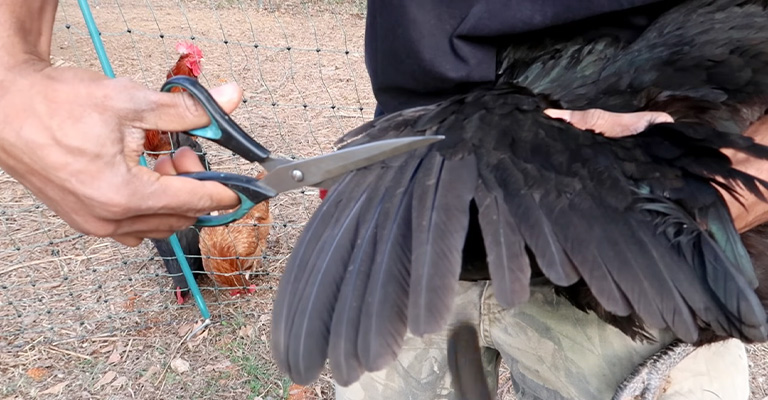
What Is Wing Clipping?
Wing clipping involves trimming the primary flight feathers of a chicken’s wings to restrict its ability to fly. Removing a few inches from these feathers alters the bird’s balance and flight control, making it difficult for them to achieve sustained flight.
Why Clip Chicken Wings?
Clipping chicken wings is the practice of cutting off some of the feathers on one or both branches of a chicken to reduce its ability to fly. Some chicken owners may choose to clip their chickens’ wings for various reasons, such as:
To Prevent Them From Flying Away Escaping Their Coop, Or Run
Chickens could be better flyers, but some breeds and individuals can flap their wings and propel themselves over fences, walls, or even trees.
This can pose several problems, such as losing your chickens to predators, traffic, or neighbors; damaging your garden, crops, or property; breaking local laws or regulations; causing nuisance or complaints.
To Protect Them From Predators Or Dangers
By clipping their wings, you can limit their flight ability and keep them within a designated area. This can give you peace of mind and protect your chickens from harm. Clipping can also help prevent chickens from being attacked by birds of prey, such as hawks or owls.
To Keep Their Feathers Neat
Clipping can also help tidy your chickens’ feathers, especially after molting them. Molting is the process of shedding old feathers and growing new ones. During this process, chickens may have uneven or ragged feathers that can affect their appearance or health.
To Give Them More Freedom And Enrichment
Clipping can also share your chickens more space and enrichment within their environment. By clipping their wings, you can allow them to free-range or explore their surroundings without worrying about them flying away or getting into trouble. Clipping can also help them interact with other chickens and form social bonds.
Pros Of Clipping Chicken Wings
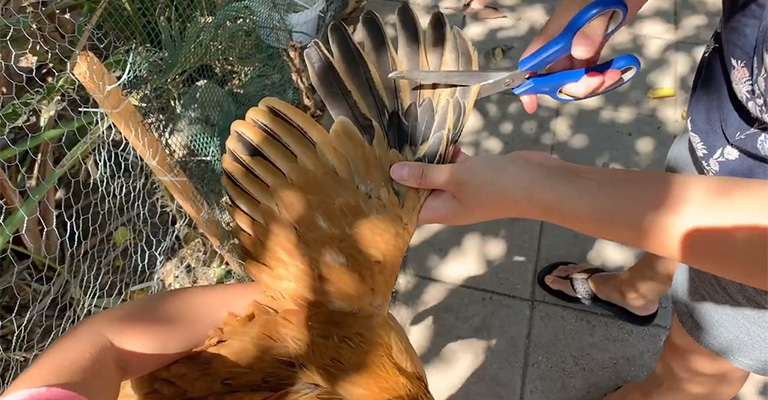
Here are some pros of clipping chicken wings-
Preventing Escape And Loss
Wing clipping can prevent chickens from flying over fences or escaping from enclosures, reducing the risk of loss or injury. This is particularly beneficial for urban or suburban backyard flocks where there might be other options than free-ranging.
Protecting Chickens From Predators
Chickens with clipped wings are less likely to venture far from their coop and are easier to protect from ground predators like dogs or foxes. This can provide your flock an added layer of security, especially in areas with high predator activity.
Reducing Property Damage
Clipped wings can help prevent chickens from roosting on unwanted areas, such as cars, patio furniture, or delicate landscaping. This can minimize property damage and maintain a cleaner and more controlled environment.
Easier Flock Management
Clipped wings can make managing and handling chickens easier during health checks, vaccinations, or introducing new birds. Restricting flight reduces the chances of birds escaping or becoming difficult to catch, facilitating flock management tasks.
Cons Of Clipping Chicken Wings
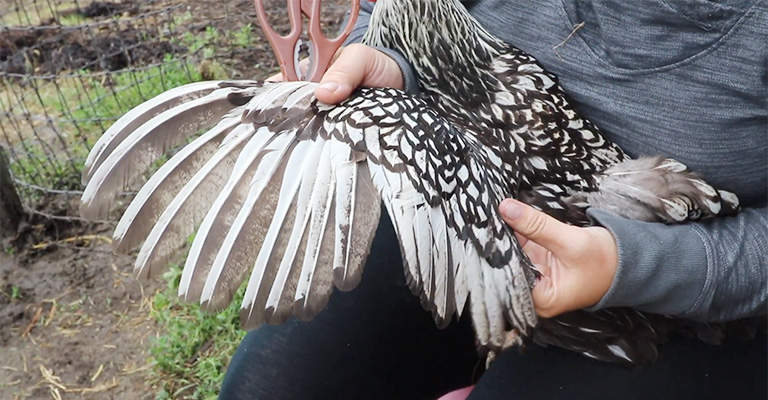
Here are some cons of clipping chicken wings-
Impaired Natural Behavior
Clipping a chicken’s wings limits its ability to exhibit natural behaviors like perching at higher elevations or exploring its environment from an aerial perspective. This restriction can impact their overall well-being and satisfaction.
Potential Stress And Anxiety
Wing clipping can cause temporary stress and anxiety in chickens, especially during the initial adjustment period. Birds may become disoriented or frustrated when attempting to fly and finding their clipped wings limit their movement.
Inability To Escape From Predators
Chickens with clipped wings may be unable to fly safely when confronted by predators. Without the ability to escape danger by taking flight, they become more vulnerable to attacks.
Wing Regrowth And Maintenance
Clipped feathers will eventually regrow, requiring regular maintenance to maintain flight restrictions. Wing feathers molt and regrow during specific times of the year, requiring continuous monitoring and clipping as needed.
How To Clip Chicken Wings?
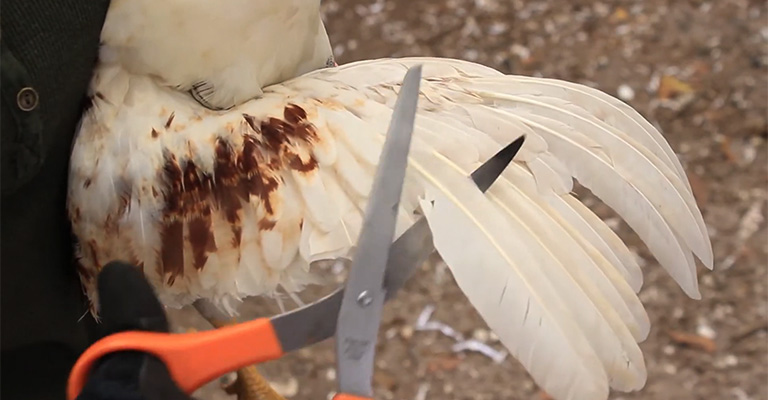
Clipping chicken wings is simple, but it requires some preparation and care. You will need the following materials:
- A sharp pair of scissors
- A towel or a blanket
- A helper (optional)
You will also need to follow these steps:
Catch The Chicken
The hardest part of clipping chicken wings may be catching the chicken you want to cut. You can try to corner the chicken in a small area, use a towel or a blanket to cover it, lure it with treats, or wait until it roosts at night. Be gentle and calm when handling the chicken, and avoid stressing it out.
Hold The Chicken
Once you have caught the chicken, you must hold it securely but gently. You can wrap it in a towel or a blanket to keep it calm and prevent it from struggling. You can also ask a helper to hold the chicken while you clip its wings.
Choose Which Wing To Clip
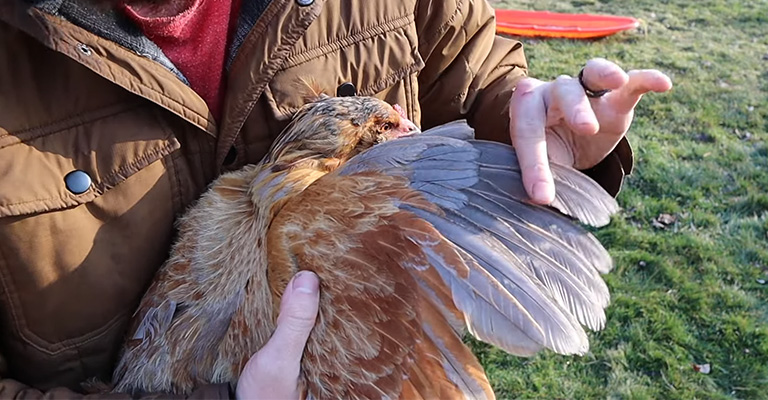
Clip either or both branches of your chicken, depending on your preference and situation. Cutting one wing will make the chicken unbalanced and unable to fly straight while clipping both wings will make it more symmetrical and less noticeable. However, clipping both wings may also reduce its ability to glide or land safely if it falls from a height.
Spread The Wing
Next, you need to spread the branch of your chicken and identify which feathers to clip. It would be best if you only clipped the primary flight feathers, the long feathers at the tip of the wing that help lift and propulsion. It would be best not to cut the secondary flight feathers, the shorter feathers closer to the body that help balance and stability.
Clip The Feathers
Using a sharp pair of scissors, cut off about half of the length of the primary flight feathers, following the natural curve of the wing.
Be careful not to cut too close to the skin or the blood-filled shafts of the feathers, as this can cause bleeding and pain. You should also avoid cutting other wing parts like bones, muscles, tendons, or nerves.
Release The Chicken
After clipping the wing(s), you can release the chicken and let it return to its flock. It may take some time to adjust to its new flight ability, so keep an eye on it and ensure it is safe and comfortable.
FAQ
Wing clipping is not necessary for all chicken breeds. Some breeds, like heavy-bodied chickens, have reduced flight capabilities naturally, making wing clipping unnecessary. Lighter and more agile breeds are typically the ones that benefit most from wing clipping.
Waiting until chickens reach their adult size, usually around 10 to 12 weeks, is recommended before attempting wing clipping. Younger chicks have fragile wings that can be easily damaged during the process.
Wing clipping is not a one-time procedure. Feathers will regrow as part of the molt cycle. Regular monitoring is required, and wing clipping should be performed whenever necessary to maintain flight restrictions.
Yes, there are alternative methods to prevent flight. These include using netting or covers to enclose outdoor areas, constructing taller fences, or providing secure and covered outdoor enclosures (chicken runs) that limit airspace while allowing freedom of movement.
Wing clipping is not a permanent procedure. As feathers molt and regrow, flight capabilities will return. To reverse wing clipping, you must allow the clipped feathers to grow back fully before the bird can fly again.
Conclusion
Wing clipping remains a topic of debate among chicken owners. While it has its benefits, such as preventing escape, protecting against predators, and facilitating flock management, it also has downsides, including impairing natural behavior and potentially causing stress.
Ultimately, the decision to clip wings should be made based on the specific needs of your flock, the environment they are kept in, and considering alternative methods of flight prevention. Prioritizing your chickens’ overall welfare and safety is essential while finding a balance that suits your specific circumstances.